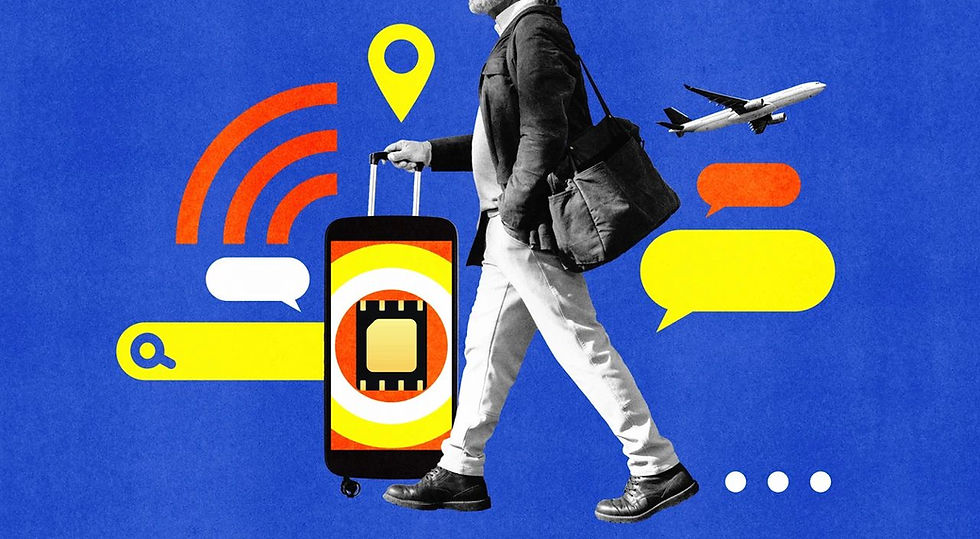Is a Travel eSIM Better Than Roaming With Your Carrier
- Jack Ranson
- Aug 8
- 4 min read

Staying connected while abroad used to be a hassle. High roaming charges, confusing international plans, and unreliable service were just part of the deal. But that's quickly changing. Enter Travel eSIMs, a digital alternative that's shaking up how travelers use data on the go.
This post clears up the confusion. It examines whether a travel eSIM is genuinely superior to your regular carrier's roaming options. By the end, readers will understand what Travel eSIMs provide. They will see how these compare to traditional roaming. Also, they'll learn why many travellers are choosing to switch.
Who Controls the Experience Carriers or Travelers?
For decades, carriers dictated how users connected abroad. Roaming was the only viable option, usually at premium rates. Travelers had little control and often returned home to shocking bills.
Now, Travel eSIMs are changing that power dynamic. Users can quickly connect to local providers in over 100 countries, not just their home network. Brands like Ezy eSIM make this change easy. They offer flexible packages that fit your destination and data needs. Users gain autonomy and avoid the rigidity of long-term contracts or bloated fees.
So, who benefits from this change? Anyone who wants to avoid overpaying for connectivity while keeping control in their hands.
What Makes Travel eSIMs Stand Out?
A Travel eSIM isn't just a digital version of a SIM card; it's an entirely different approach to mobile service.
It's software-based and embedded in a smartphone or device. This means no physical cards, no waiting for delivery, and no searching for SIM kiosks at the airport.
Here's what sets them apart:
Instant setup: Activate before you land or within minutes of arrival. No paperwork. No lines.
Transparent pricing: See costs upfront. Pick data plans based on country, region, or duration.
Local rates, globally: Gain access to local carrier networks at local prices without requiring a local ID.
Travel eSIMs differ from traditional roaming. Users aren't locked to their home carrier's overseas partners, which can vary in quality. Instead, they connect to the best networks available. It's a smarter way to travel, with performance and price both in mind.
When Does a Travel eSIM Make the Most Sense?
Travel eSIMs shine in scenarios where flexibility is key. They adapt better than roaming, whether it's a weekend trip or a multi-country tour.
They're handy for:
Frequent flyers who visit different countries each month.
Remote workers need dependable service for video calls and uploads.
Vacationers who want to stay online without checking their bill every night.
Digital nomads live out of a suitcase and switch continents regularly.
Unlike roaming, which often resets or surges after a billing cycle, Travel eSIMs are pre-paid. That means no hidden fees or surprises when the trip ends.
Where Do Travel eSIMs Work Best?
Global reach is one of the biggest strengths of Travel eSIMs; options like Ezy eSIM offer broad coverage that often outpaces traditional roaming.
Instead of relying on one partner network in a country, these eSIMs automatically connect to the best available provider. This means stronger signal, better speeds, and fewer frustrating drops.
Top-performing regions include:
Europe, where cross-border plans make continent-hopping easy.
Asia, where local carriers offer generous data at competitive prices.
North America, where connectivity standards are high but roaming charges often are too.
With this coverage, travelers aren't just connected. They can explore freely, choosing where to go, not just where their carrier lets them.
Why Carriers Might Be Falling Behind?
Traditional carriers created their international roaming model for a different time. Back then, people seldom left their home country and didn't expect to stay connected all the time.
But things have changed:
Travel eSIMs offer up-front pricing, while roaming plans often bury details in fine print.
eSIMs reduce plastic waste, eliminating the need for disposable SIM cards.
Travelers don't want to wait days for a SIM or spend hours configuring a device. Seamless activation is now expected.
For today's users, Travel eSIMs offer convenience and fairness. This makes traditional roaming services seem outdated.
How to Get Started Without the Guesswork?
Setting up a Travel eSIM is simpler than most expect. Users typically just:
Choose a provider that supports their destination.
Select a plan based on the length of stay or expected data use.
Scan a QR code to activate instantly.
Start browsing with no physical installation required and no technical skills needed.
Brands like Ezy eSIM have streamlined this process down to a few clicks. Support teams are available 24/7 to assist with setup or switching between regions.
Many Travel eSIMs focus on privacy. They ensure security and encryption right from the first connection. If a phone supports eSIM, the process is quick, reliable, and straightforward. This is different from traditional roaming.
In a Nutshell
Travel eSIMs offer an affordable and secure mobile data solution, helping to avoid common carrier roaming issues. Generally, they are better than traditional roaming options. This shift isn't just about saving money; it's driven by changing digital expectations from mobile providers.
The eSIM technology is evolving. Before your next trip, consider a Travel eSIM for a hassle-free experience. Check device compatibility and compare data plans for your destination; it might pleasantly surprise you.









Comments